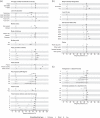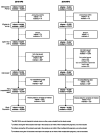Trends and disparities in breastfeeding initiation in France between 2010 and 2016: Results from the French National Perinatal Surveys
- PMID: 35909344
- PMCID: PMC9480949
- DOI: 10.1111/mcn.13410
Trends and disparities in breastfeeding initiation in France between 2010 and 2016: Results from the French National Perinatal Surveys
Abstract
Breastfeeding (BF) initiation rates in French maternity units are among the lowest in Europe. After increasing for several years, they decreased between 2010 and 2016, although several maternal characteristics known to be positively associated with BF in France were more frequent. We aimed to (1) quantify adjusted trends in BF initiation rates between 2010 and 2016; (2) examine associations between BF initiation rates and newborn, maternal, maternity unit, and department-level characteristics. Using data from the 2010 (n = 12,224) and 2016 (n = 11,089) French National Perinatal Surveys, we analysed BF initiation (exclusive, mixed, and any) through a succession of six mixed-effect multinomial regression models, progressively adding adjustment covariates. Adjusted exclusive and any BF initiation rates decreased by 9.6 and 4.5 points, respectively, versus by 7.7 and 1.8 points, respectively, in the crude analysis. In both years, adjusted exclusive and any BF initiation rates were lowest in the following categories of mothers: low education level, single, high body mass index and multiple or premature births. Exclusive BF initiation decreased most in primiparous mothers, those with the lowest household income, mothers that had a vaginal delivery, women born in an African country and those who delivered in a maternity unit without Baby-Friendly Hospital Initiative designation. The 2010-2016 decrease in BF initiation rates in France cannot be explained by changes in mothers' characteristics; quite the opposite, adjustment increased its magnitude. Additional efforts should be put in place to understand why this decrease is particularly sharp in some subgroups of mothers.
Keywords: France; breastfeeding initiation; exclusive breastfeeding; inequalities; mixed breastfeeding; trends.
© 2022 The Authors. Maternal & Child Nutrition published by John Wiley & Sons Ltd.
Conflict of interest statement
The authors declare no conflict of interest.
Figures




Comment in
-
Comment on "Trends and disparities in breastfeeding initiation in France between 2010 and 2016: Results from the French National Perinatal Surveys".Matern Child Nutr. 2023 Jul;19(3):e13494. doi: 10.1111/mcn.13494. Epub 2023 Mar 30. Matern Child Nutr. 2023. PMID: 36999241 Free PMC article. No abstract available.
References
-
- Besag, J. , York, J. , & Mollie, A. (1991). Bayesian image restoration, with two applications in spatial statistics. Annals of the Institute of Statistical Mathematics, 43, 1–59.
-
- Bhattacharjee, N. V. , Schaeffer, L. E. , Marczak, L. B. , Ross, J. M. , Swartz, S. J. , Albright, J. , Gardner, W. M. , Shields, C. , Sligar, A. , Schipp, M. F. , Pickering, B. V. , Henry, N. J. , Johnson, K. B. , Louie, C. , Cork, M. A. , Steuben, K. M. , Lazzar‐Atwood, A. , Lu, D. , Kinyoki, D. K. ,… Hay, S. I. (2019). Mapping exclusive breastfeeding in Africa between 2000 and 2017. Nature Medicine, 25, 1205–1212. 10.1038/s41591-019-0525-0 - DOI - PMC - PubMed
-
- Blondel, B. , Coulm, B. , Bonnet, C. , Goffinet, F. , & Le Ray, C. (2017). Trends in perinatal health in metropolitan France from 1995 to 2016: Results from the French National Perinatal Surveys. Journal of Gynecology Obstetrics and Human Reproduction, 46(10), 701–713. 10.1016/j.jogoh.2017.09.002 - DOI - PubMed
-
- Blondel, B. , Coulm, B. , Bonnet, C. , Vanhaesebrouck, A. , Vilain, A. , Fresson, J. , & Raynaud, P. (2017). Enquête nationale périnatale 2016. Les naissances et les établissements, situation et évolution depuis 2010. http://drees.solidarites-sante.gouv.fr/etudes-et-statistiques/publicatio...
MeSH terms
LinkOut - more resources
Full Text Sources
Medical
Miscellaneous

